low beam PONTIAC BONNEVILLE 1993 Owners Manual
[x] Cancel search | Manufacturer: PONTIAC, Model Year: 1993, Model line: BONNEVILLE, Model: PONTIAC BONNEVILLE 1993Pages: 322, PDF Size: 16.31 MB
Page 74 of 322
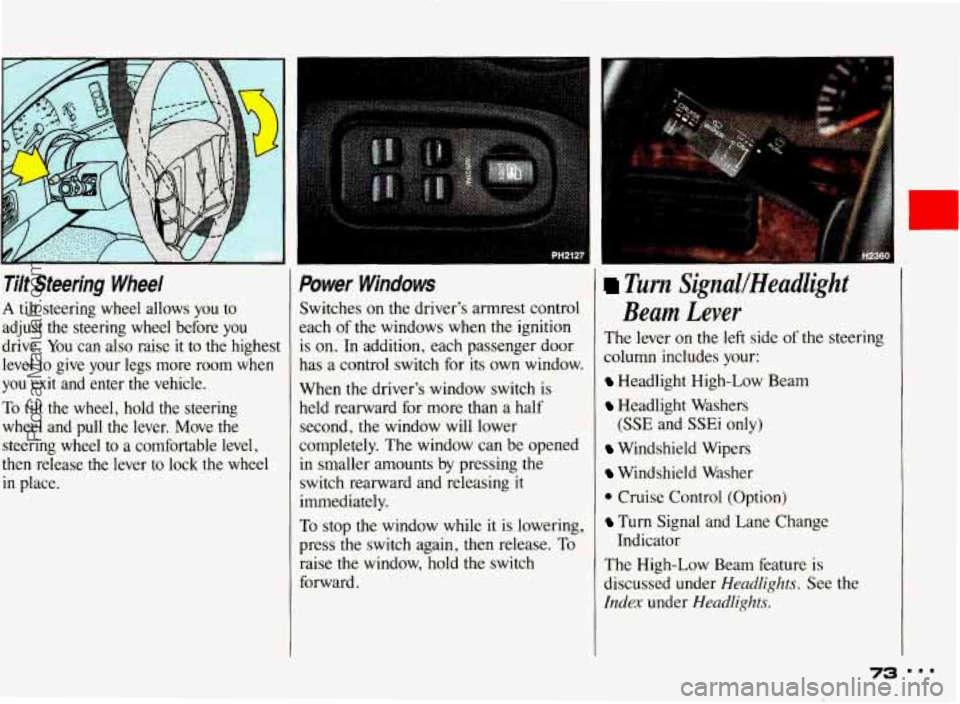
Tilt Steering Wheel
A tilt steering wheel allows you to
adjust the steering wheel before you
drive. You can
also raise it to the highest
level to give your legs more room when
you
exit and enter the vehicle.
To tilt the wheel, hold the steering
wheel and
pull the lever. Move the
steering wheel to a comfortable level,
then release the lever
to lock the wheel
in place.
Power Windows
Switches on the driver’s armrest control
each
of the windows when the ignition
is
on. In addition, each passenger door
has a control switch for its own window.
When the driver’s window switch is
held rearward for more than a half
second, the window will lower
completely. The window can be opened
in smaller amounts by pressing the
switch rearward and releasing it
immediately.
To stop the window while it is lowering,
press the switch again, then release.
To
raise the window, hold the switch
forward.
r
Turn SignallHeadlight
Beam Lever
The lever on the left side of the steering
column includes your:
Headlight High-Low Beam
Headlight Washers
Windshield Wipers
Windshield Washer
0 Cruise Control (Option)
Turn Signal and Lane Change
The High-Low Beam feature is
discussed under
Headlights. See the
Index under Headlights.
(SSE and SSEi only)
Indicator
73 ==.
t ProCarManuals.com
Page 77 of 322
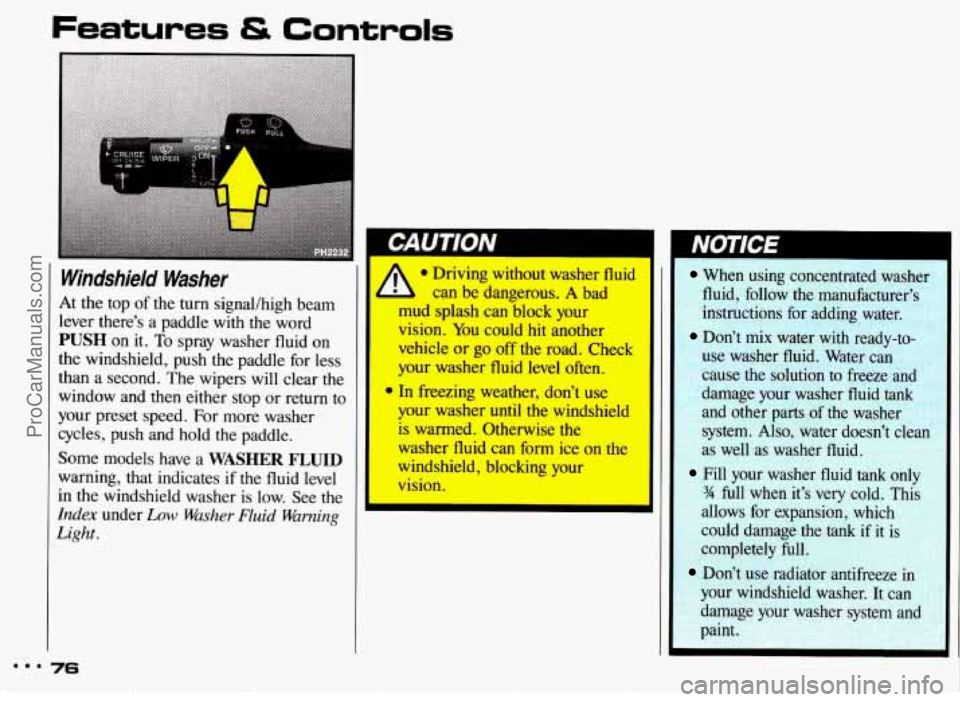
Windshield Washer
At the top of the turn signal/high beam
lever there’s a paddle with the word
PUSH on it. To spray washer fluid on
the windshield, push the paddle for less
than a second. The wipers will clear the
window and then either stop or return to
your preset speed. For more washer
cycles, push and hold the paddle.
Some models have a
WASHER FLUID
warning, that indicates if the fluid level
in the windshield washer is low. See the
Index under Low Washer Fluid Warning
Light.
When using concentrated washer
fluid, follow the manufacturer’s
instructions for adding water.
Don’t mix water with ready-to-
use washer fluid. Water can
cause the solution
to freeze an ’
damage your washer fluid tank
and other parts of the washer
system.
Also, water doesn’t clean
as well as washer fluid.
Fill your washer fluid tank only
% full when it’s very cold. This
allows for expansion, which
could damage the
tank if it is
completely full.
Don’t use radiator antifreeze in
your windshield washer. It can
damage your washer system and
paint.
Y ProCarManuals.com
Page 78 of 322
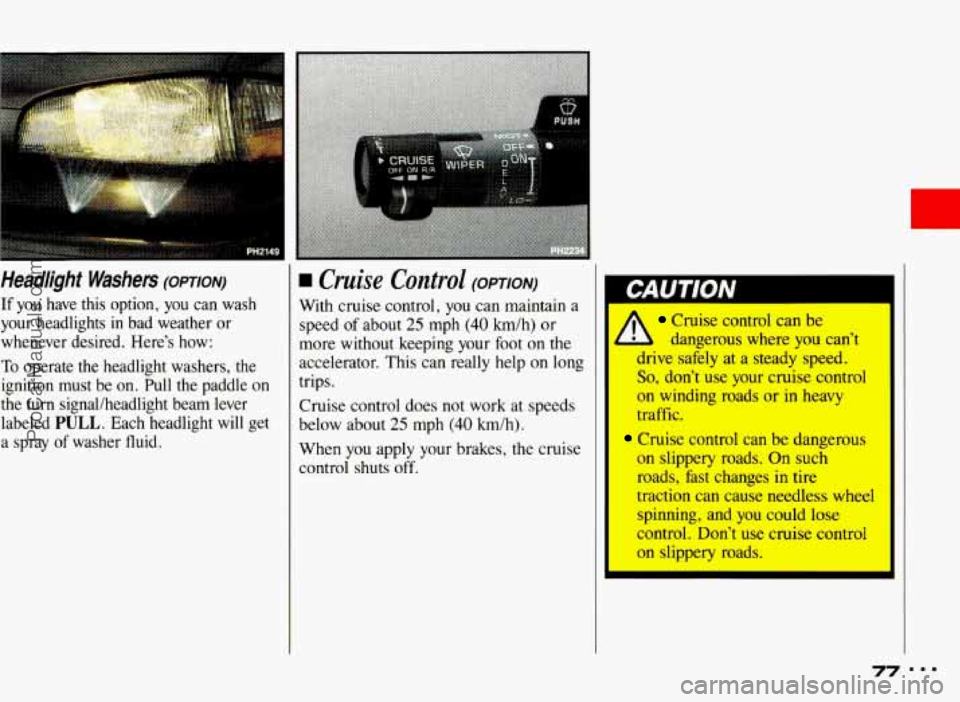
Headlight Washers (opT1oN)
If you have this option, you can wash
your headlights
in bad weather or
whenever desired. Here’s how:
To operate the headlight washers, the
ignition must be on. Pull the paddle on
the turn signal/headlight beam lever
labeled
PULL. Each headlight will get
a spray
of washer fluid.
H Cruise Control (OPTION)
With cruise control, you can maintain a
speed of about
25 mph (40 h/h) or
more without keeping your foot on the
accelerator. This can really help
on long
trips.
Cruise control does not work at speeds
1
below about 25 mph (40 km/h).
When you apply your brakes, the cruise
control shuts
off.
Cruise control can be
- b dangerous where you can’t
drive safely at a steady speed.
So, don’t use your cruise control
on winding roads or in heavy
traffic.
,Cruise control can be dangerous
on slippery roads. On such
roads, fast changes in tire
traction can cause needless wheel
spinning, and you could lose
control. Don’t use cruise control
on slippery mads.
77
ProCarManuals.com
Page 83 of 322
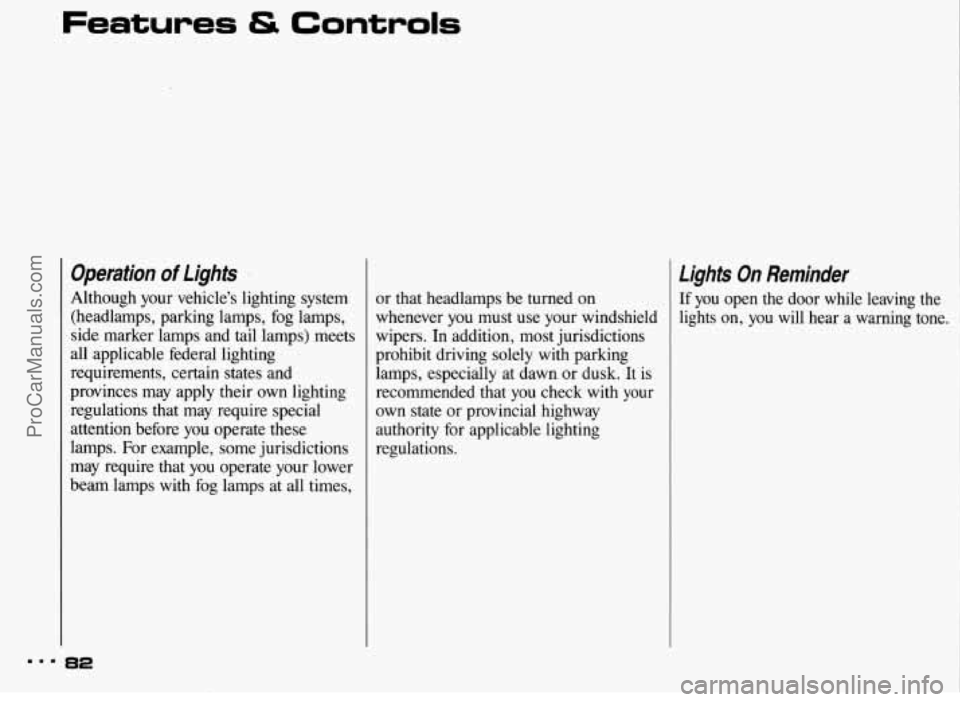
...
Features & Controls
Operation of lights '
Although your vehicle's lighting system (headlamps, parking lamps, fog lamps,
side marker lamps and tail lamps) meets
all applicable federal lighting
requirements, certain states and
provinces may apply their own lighting
regulations that may require special
attention before you operate these
lamps. For example, some jurisdictions
may require that you operate your lower
beam lamps with fog lamps at all times,
62
or that headlamps be turned on
whenever you must use your windshield wipers. In addition, most jurisdictions
prohibit driving solely with parking
lamps, especially at dawn or dusk. It is
recommended that you check with your
own state or provincial highway
authority for applicable lighting
regulations.
lights On Reminder
If you open the door while leaving the
lights on, you will hear a warning tone.
ProCarManuals.com
Page 84 of 322
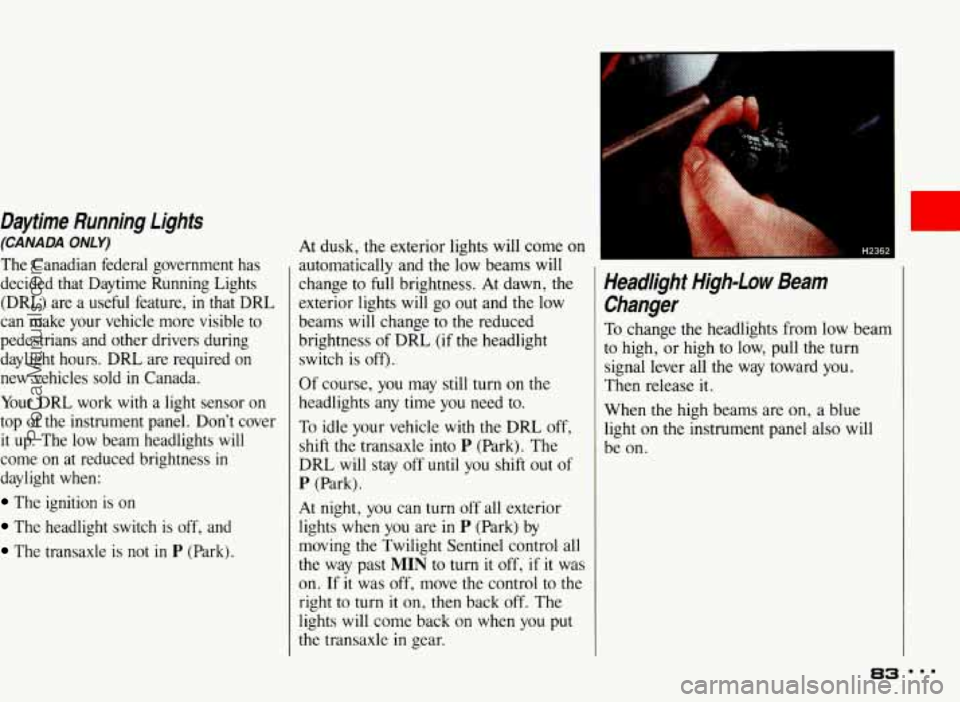
Daytime Running Lights
(CANADA ONLY)
The Canadian federal government has
decided that Daytime Running Lights (DRL) are a useful feature,
in that DRL
can make your vehicle more visible
to
pedestrians and other drivers during
daylight hours. DRL are required
on
new vehicles sold in Canada.
Your DRL work
with a light sensor on
top of the instrument panel. Don't cover
it up. The low beam headlights will
come on at reduced brightness
in
daylight when:
The ignition is on
The headlight switch is off, and
The transaxle is not in P (Park). At
dusk, the exterior lights will come on
automatically and the low beams will
change
to full brightness. At dawn, the
exterior lights will go out and the low
beams
will change to the reduced
brightness of DRL
(if the headlight
switch
is off)..
Of course, you may still turn on the
headlights any time
you need to.
To idle your vehicle
with the DRL off,
shift the transaxle into
P (Park). The
DRL will stay off until you shift out of
P (Park).
At night, you can turn off all exterior
lights
when you are in P (Park) by
moving the Twilight Sentinel control all
the way past
MIN to turn it off, if it was
on.
If it was off, move the control to the
right to turn
it on, then back off. The
lights will come back on
when you put
the transaxle
in gear.
I
r
Headlight High-Low Beam
Changer
To change the headlights from low beam
to high, or high
to low, pull the turn
signal lever all the way toward you.
Then release it.
When the high beams are
on, a blue
light
on the instrument panel also will
be
on.
83 ...
ProCarManuals.com
Page 86 of 322
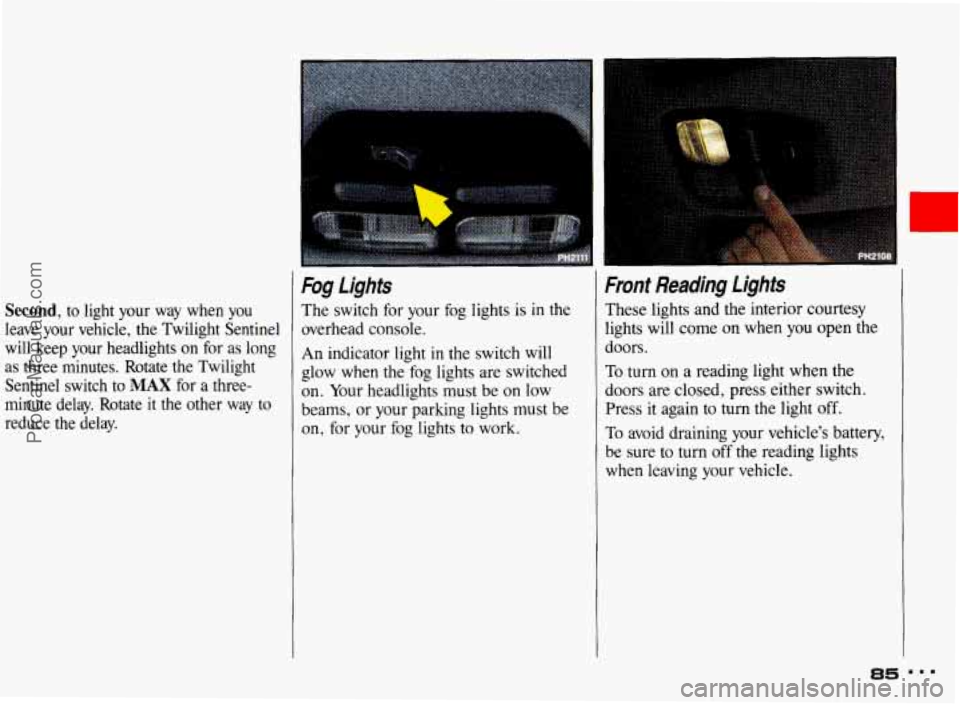
Second, to light your way when you
leave your vehicle, the Twilight Sentinel
will keep your headlights on for
as long
as three minutes. Rotate the Twilight
Sentinel switch to
MAX for a three-
minute delay, Rotate it the other way
to
reduce the delay.
Fog Lights
The switch for your fog lights is in the
overhead console.
An indicator light
in the switch will
glow when the fog lights are switched
on. Your headlights must be on low
beams, or your parking lights must be
on, for your fog lights to work.
Front Reading Ljghts
These lights and the interior courtesy
lights will come
on when you open the
doors.
To turn on
a reading light when the
doors are closed, press either switch.
Press it again to turn
the light off.
To avoid draining your vehicle's battery,
be sure to turn off the reading lights
when leaving your vehicle.
ProCarManuals.com
Page 113 of 322
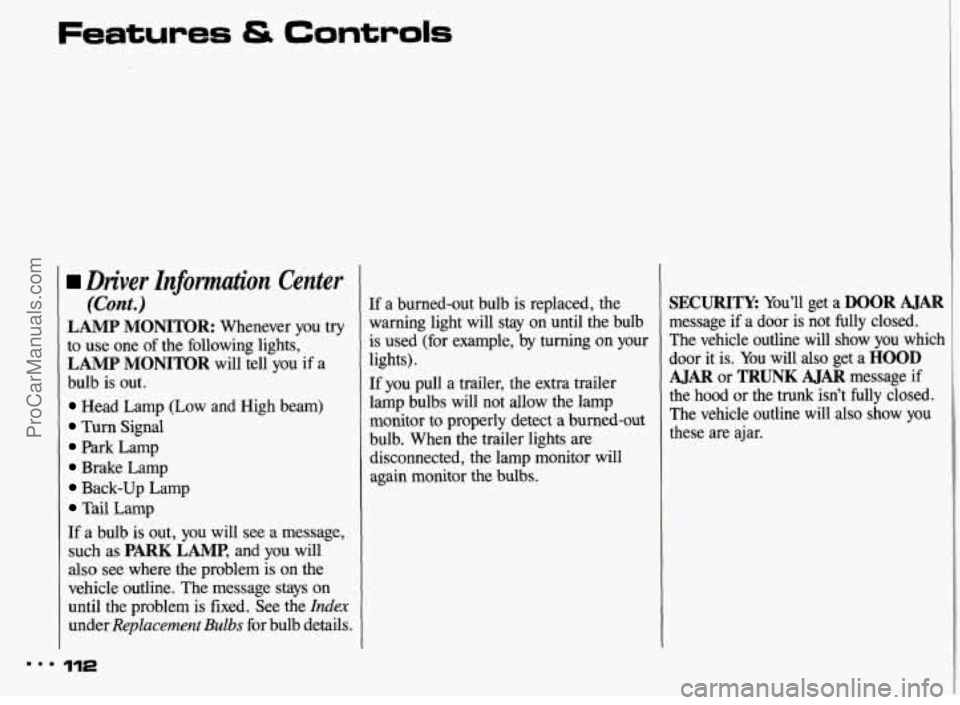
Features & Controls
Diver Information Center
(Cont.)
LAMP MONITOR: Whenever you try
to use one of the following lights,
LAMP MONITOR will tell you if a
bulb is out.
Head Lamp (Low and High beam)
Turn Signal
Park Lamp
Brake Lamp
Back-up Lamp
Tail Lamp
If
a bulb is out, you will see a message,
such as PARK LAMP, and you will
also see where the problem is on the
vehicle outline. The message
stays on
until the problem is fixed. See the
Index
under Replacement Bulbs for bulb details.
112 mmm
If a burned-out bulb is replaced, the
warning light will stay on until the bulb
is used (for example, by turning on your
lights).
If you pull a trailer, the extra trailer
lamp bulbs will not allow the lamp
monitor to properly detect a burned-out
bulb. When the trailer lights are
disconnected, the lamp monitor will
again monitor the bulbs.
SECURITY You’ll get a DOOR AJAR
message if a door is not fully closed.
The vehicle outline will show
you which
door it is. You will also get a
HOOD
AJAR or TRUNK AJAR message if
the hood or the trunk isn’t fully closed.
The vehicle outline will also
show you
these are ajar.
ProCarManuals.com
Page 117 of 322
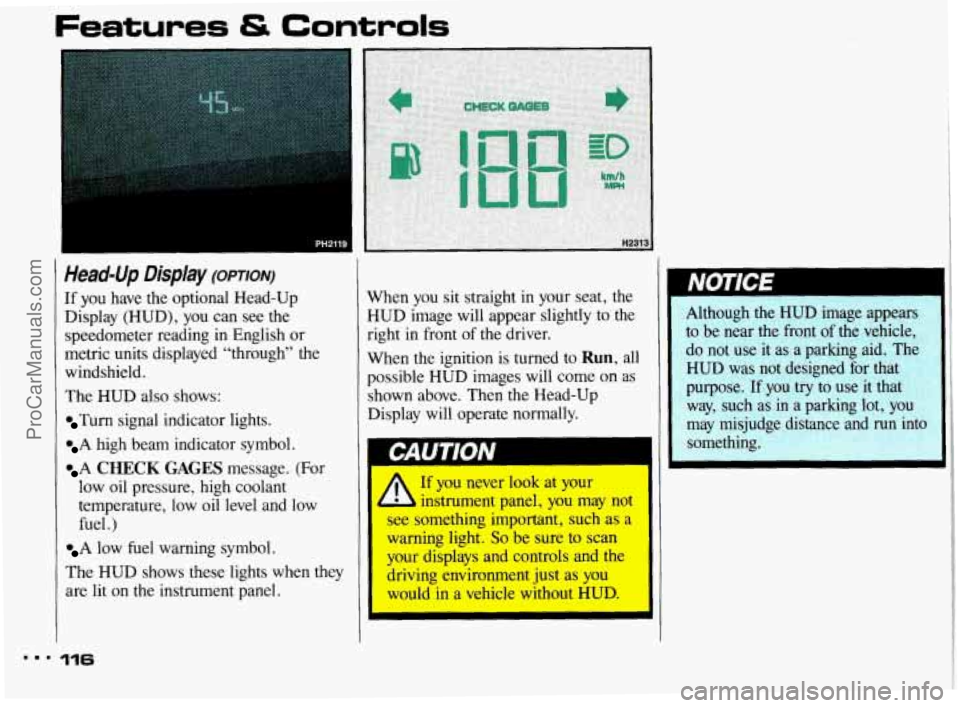
Features & Controls
pH2119
Head-Up Display (omorq
If you have the optional Head-Up
Display (HUD), you can see the
speedometer reading in English or
metric units displayed “through” the
windshield.
The HUD
also shows:
Turn signal indicator lights.
A high beam indicator symbol.
A CHECK GAGES message. (For
low oil pressure, high coolant
temperature, low oil level and low
fuel .)
A low fuel warning symbol.
The HUD shows these lights when they
are lit
on the instrument panel.
... 116
When you sit straight in your seat, the
HUD image will appear slightly to the
right in front
of the driver.
When the ignition is turned
to Run, all
possible HUD images will come on as
shown above. Then the Head-Up
Display will operate normally.
14
NOTEE
Although the HUD image appears
to be near the front
of the vehicle,
do not use it as a parking aid. The
HUD was not designed
for that
purpose.
If you try to use it that
way, such as in a parking lot,
you
may misjudge distance and run into
something.
If you never look at your
b instrument panel, you may not
see something important, such as a
warning light. So be sure to scan
your displays and controls and the
driving environment just
as you
would in a vehicle without
HUD.
ProCarManuals.com
Page 162 of 322
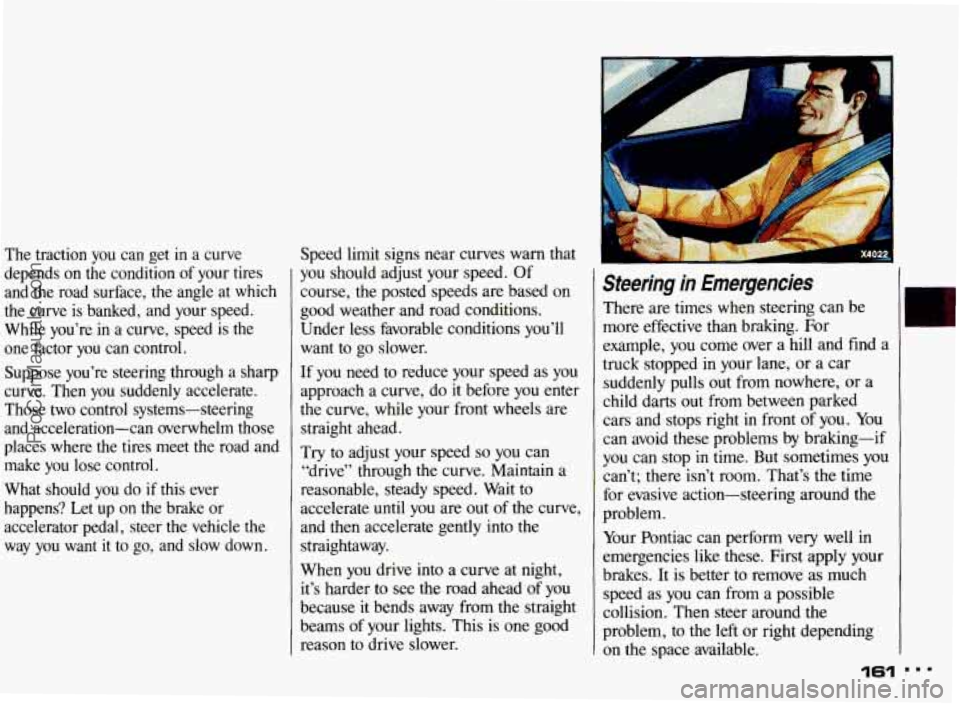
The traction you can get in a curve
depends on the condition of your tires
and the road surface,
the angle at which
the curve is banked, and your speed.
While you’re
in a curve, speed is the
one factor you can control.
Suppose you’re steering through a sharp
curve. Then you suddenly accelerate.
Those two control systems-steering
and acceleration-can overwhelm those
places where the tires meet the road and make you lose control.
What should you do if this ever
happens? Let up on
the brake or
accelerator pedal, steer the vehicle the
way you want it to go, and slow down. Speed limit signs near
curves warn that
you should adjust your speed. Of
course, the posted speeds are based on
good weather and road conditions.
Under less favorable conditions you’ll
want to go slower.
If you need to reduce your speed as you
approach a curve, do
it before you enter
the curve, while your front wheels are
straight ahead.
Try to adjust your speed
so you can
“drive” through the curve. Maintain a
reasonable, steady speed. Wait to
accelerate until you are out of the curve,
and then accelerate gently into the
straightaway.
When you drive into a curve at night,
it’s harder to see the road ahead of you
because it bends away from the straight
beams of your lights. This
is one good
reason to drive slower.
Steering in Emergencies
There are times when steering can be
more effective than braking. For
example, you come over a hill and find a
truck stopped in your lane, or a car
suddenly pulls out from nowhere, or a
child darts
out from between parked
cars and stops right in front of you. You
can avoid these problems by braking-if
you can stop
in time. But sometimes you
can’t; there isn’t room. That’s the time
for evasive action-steering around the
problem.
Your Pontiac can perform very well in
emergencies like these. First apply your
brakes.
It is better to remove as much
speed as you can from a possible
collision. Then steer around the
problem, to the left or right depending
on the space available.
161
ProCarManuals.com
Page 167 of 322
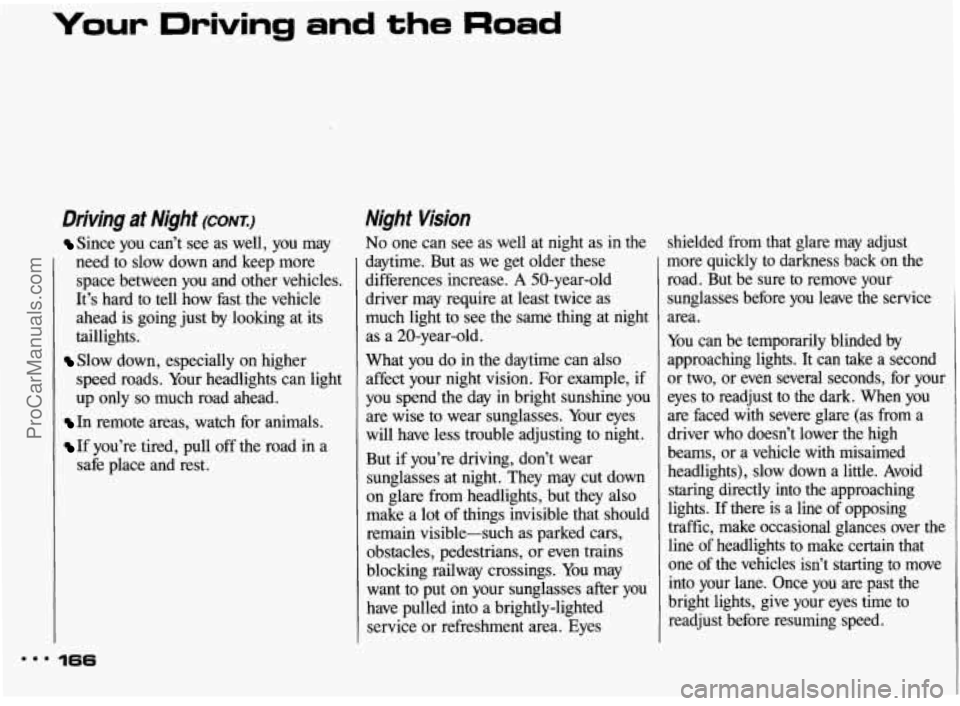
Your Driving and the Road
Driving at Night (CONT.:)
Since you can’t see as well, you may
need to slow down and keep more
space between you and other vehicles.
It’s hard
to tell how fast the vehicle
ahead is going just by looking at its
taillights.
Slow down, especially on higher
speed roads, Your headlights can light
up only
so much road ahead.
In remote areas, watch for animals.
If you’re tired, pull off the road in a
safe place and rest.
Night Hsion
No one can see as well at night as in the
daytime. But as we get older these
differences increase.
A 50-year-old
driver may require at least twice as
much light
to see the same thing at night
as a 20-year-old.
What you do in the daytime can also
affect your night vision. For example, if
you spend the day in bright sunshine you
are wise to wear sunglasses. Your eyes
will have less trouble adjusting to night.
But if you’re driving, don’t wear
sunglasses at night. They may cut down
on glare from headlights, but they also
make a lot of things invisible that should
remain visible-such as parked cars,
obstacles, pedestrians, or even trains
blocking railway crossings.
You may
want to put
on your sunglasses after you
have pulled into a brightly-lighted
service or refreshment area. Eyes shielded from that glare
may adjust
more quickly to darkness back
on the
road. But be sure to remove your
sunglasses before you leave the service
area.
You can be temporarily blinded by
approaching lights. It can take a second or two, or even several seconds, for your
eyes to readjust to the dark. When you
are faced with severe glare (as from a
driver who doesn’t lower the high
beams, or a vehicle with misaimed
headlights), slow down a little. Avoid
staring directly into the approaching
lights.
If there is a line of opposing
traffic, make occasional glances over the line
of headlights to make certain that
one of the vehicles isn’t starting to move
into your lane. Once you are past the
bright lights, give your eyes time to
readjust before resuming speed.
mmm 166
ProCarManuals.com